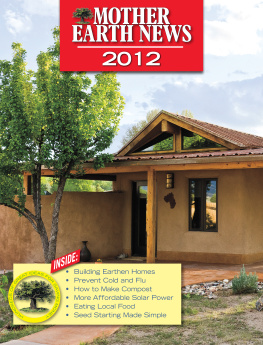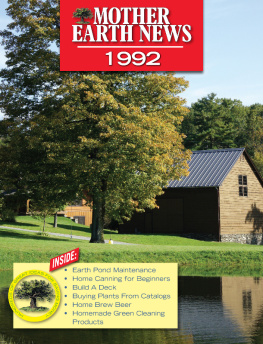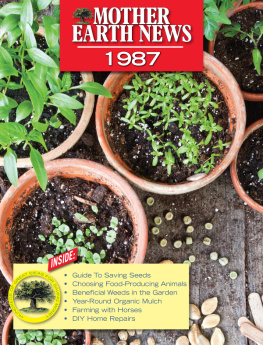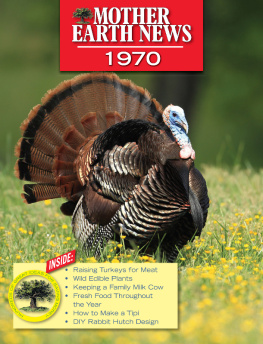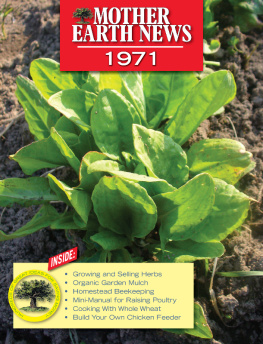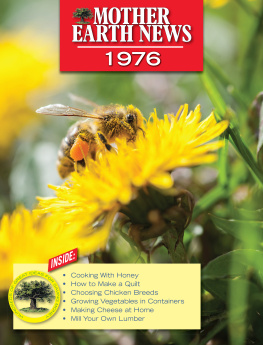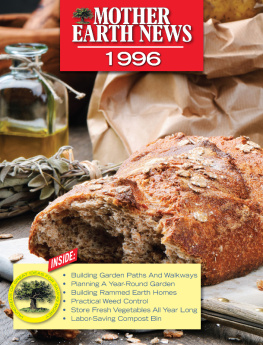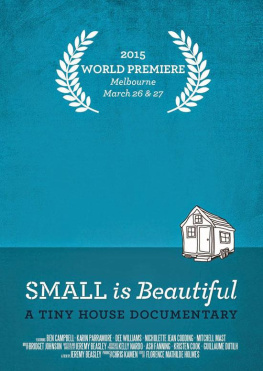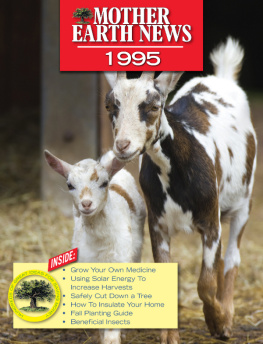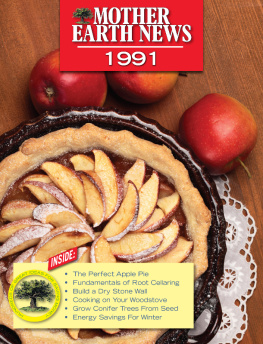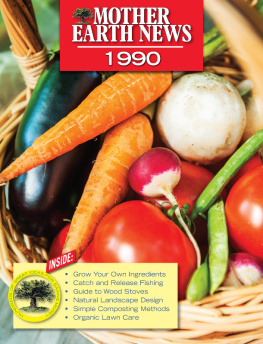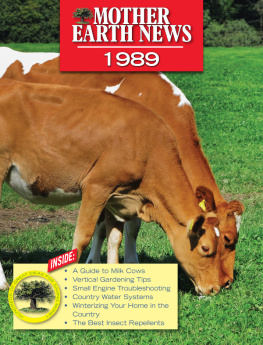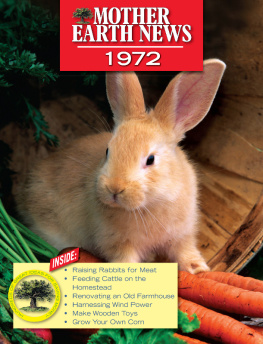Mother Earth News - Mother Earth News 2012
Here you can read online Mother Earth News - Mother Earth News 2012 full text of the book (entire story) in english for free. Download pdf and epub, get meaning, cover and reviews about this ebook. year: 2012, publisher: Mother Earth News, genre: Science / Home and family. Description of the work, (preface) as well as reviews are available. Best literature library LitArk.com created for fans of good reading and offers a wide selection of genres:
Romance novel
Science fiction
Adventure
Detective
Science
History
Home and family
Prose
Art
Politics
Computer
Non-fiction
Religion
Business
Children
Humor
Choose a favorite category and find really read worthwhile books. Enjoy immersion in the world of imagination, feel the emotions of the characters or learn something new for yourself, make an fascinating discovery.
- Book:Mother Earth News 2012
- Author:
- Publisher:Mother Earth News
- Genre:
- Year:2012
- Rating:3 / 5
- Favourites:Add to favourites
- Your mark:
- 60
- 1
- 2
- 3
- 4
- 5
Mother Earth News 2012: summary, description and annotation
We offer to read an annotation, description, summary or preface (depends on what the author of the book "Mother Earth News 2012" wrote himself). If you haven't found the necessary information about the book — write in the comments, we will try to find it.
Mother Earth News 2012 — read online for free the complete book (whole text) full work
Below is the text of the book, divided by pages. System saving the place of the last page read, allows you to conveniently read the book "Mother Earth News 2012" online for free, without having to search again every time where you left off. Put a bookmark, and you can go to the page where you finished reading at any time.
Font size:
Interval:
Bookmark:


Growing beets will give you delicious, colorful roots and nutritious greens. Closely related to spinach and chard, and once called blood turnips because of their bright red juice, beets also can be golden, white or striped. If you keep livestock, you can grow special varieties of forage or mangel beets to feed to your animals in winter.
Red table beets produce edible greens in 35 days, followed by round or cylindrical roots a month later. Leaves from most red beets have red stems and leaf veins similar to red-leafed chard varieties.
White, orange and golden beets are prized for their mild, nutty flavor. Because they dont bleed red juice, these beets are best for roasting with other vegetables.
Storage beets are table beet varieties that excel when grown for fall harvest followed by winter storage in your refrigerator or root cellar.
Mangel beets, often called forage beets or mangel-wurzel beets, grow huge roots weighing from 5 to 20 pounds each that can be used as livestock fodder in winter.
For more detailed information on each type of beet and our list of recommended varieties, see our Beets at a Glance chart.
Begin planting beet seeds directly in the garden one month before your last spring frost date, followed by a second planting two to three weeks later. Beet seeds can germinate in cool soil, but they sprout best when soil temperatures are above 50 degrees Fahrenheit.
Start planting beets for fall harvest 10 to 12 weeks before your expected first fall frost. (Learn more about your regions planting dates by using our What to Plant Now pages.)
Cultivate the planting site and mix in a 1-inch layer of cured compost and a standard application of organic fertilizer. As long as your soil is not alkaline, you can also mix in a sprinkling of wood ashes for additional potassium, which will support more vigorous beet growth. All beets grow best in fertile soil with a pH between 6.2 and 7.0. Water the prepared bed, and plant beet seeds half an inch deep and 2 inches apart, in rows spaced 12 inches apart.
Beet seeds germinate in five to 10 days if kept constantly moist. Repeated watering can cause some soils to crust on the surface, which can inhibit the emergence of seedlings. Cover seeded rows with boards or burlap for a few days after planting to reduce surface crusting. This technique is also useful when planting beets for fall harvest in warm summer soil. Just be sure to remove the covers as soon as the beet seedlings break the surface.
Beet seeds are actually capsules with two or more seeds inside, so thinning is essential to growing plump roots. Relieve early crowding by snipping out the weaker seedlings soon after germination. A week later, thin seedlings to 3 to 4 inches apart.
Beets grow best when temperatures average about 65 degrees, so early plantings grow faster if covered with row covers. Pull weeds early and often, and use light mulches of grass clippings or compost to help maintain even soil moisture. Beet roots often naturally push up out of the ground as they mature, and this exposure to sun can cause the shoulders of white or yellow beets to become green and tough. Cover the roots with mulch or loose soil to ease the problem.
Beet greens can be harvested anytime, and picking a leaf or two from each plant wont compromise their root growth, but many gardeners wait until beets are ready to pull to harvest the inner leaves. Beet leaves taste best when they are about 6 inches long, but baby greens are wonderful in salads and bigger leaves still cook up nicely. Leave a few spring-sown beets in the garden through summer to enjoy a steady production of young greens.
Carefully wash harvested beets in cool water. Use a sharp knife to cut off all but 1 inch of the beet tops, but leave the taproot intact. Removing the tops prevents moisture loss from the roots. Store washed, trimmed beets in your refrigerator or a cool root cellar for several months. You also can make pickled beets and process them in a water bath canner for longer storage (get a recipe online in How to Can Pickled Beets).
Bury mangel beets in a pit to use as needed for livestock fodder in winter.
Beets are biennial plants that produce flowers and seeds in their second year, following exposure to cold weather. Beets can survive winter to Zone 6 if protected from deer and harsh weather with a row cover tunnel. In colder climates, store three nice beets through winter and replant them in your garden as soon as the soil thaws (be sure the variety you save isnt a hybrid).
Tiny beet flowers are wind-pollinated, so set plants close together for good pollination. Beet flower spikes can reach 4 feet tall, so they benefit from staking. Snipping off the ends of long flower spikes can help speed the maturation of seeds. When the seed spikes begin drying to tan, cut them and place them in a paper bag in a warm, dry place. After two weeks, rub the seeds to separate them, sift out debris, and store the seeds in a cool, dry place. Beet seeds can remain viable for four years.
Flea beetles make tiny holes in beet leaves, but healthy plants quickly outgrow the damage. These pests also love mustard greens and arugula, so diversity among your spring greens can limit damage.
Leaf miners make meandering lines in beet leaves. The larvae of a small fly, leaf miners feed inside the leaf, so pesticides cannot control them. Clip off affected leaves and bury them in an active compost pile to prevent a second generation.
Rabbits eagerly eat beet greens, while voles may attack beets from below just as they form big roots. You can exclude these and other animal pests with appropriate fencing (see Install the Best Garden Fences).
Beet leaves also can suffer from Cercospora leaf spot, a fungal disease aggravated by poor plant nutrition and warm, humid weather. Affected leaves develop small spots and cracked, tan edges. You usually can prevent problems with good plant rotation practices, adequate thinning and a high level of soil fertility.
Beets can be boiled, steamed, roasted, or shredded and eaten raw. Roasting concentrates beet sugars. Use a vegetable peeler to remove skins from beets before roasting them with other vegetables. Otherwise, cooking beets in their skins makes the peels easy to slip off after they cool.
The flavor of cooked beets pairs well with caraway, cumin, dill or horseradish. Enjoy a simple salad of chilled, cooked beets and crumbled feta with a light vinaigrette. Topped with a dollop of sour cream, beet soup (borscht) is a staple in many Eastern European countries. Beet greens are high in vitamin A, and beet roots are a good source of vitamin C, manganese and folate. Mixing varieties of beets that are different colors, such as golden beets and striped Chioggia beets, creates a stunning edible display.
Font size:
Interval:
Bookmark:
Similar books «Mother Earth News 2012»
Look at similar books to Mother Earth News 2012. We have selected literature similar in name and meaning in the hope of providing readers with more options to find new, interesting, not yet read works.
Discussion, reviews of the book Mother Earth News 2012 and just readers' own opinions. Leave your comments, write what you think about the work, its meaning or the main characters. Specify what exactly you liked and what you didn't like, and why you think so.

